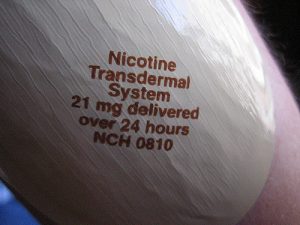
Smoking in the general population is on the decline. However, in people with severe mental disorders (SMDs) such as schizophrenia and bipolar disorder the estimated smoking prevalence rate is anywhere between 50-80%. High rates of medical morbidity and severely reduced life expectancy are associated with increased prevalence rates in these individuals.
Pharmacological treatments for smoking cessation are effective in the general population. We have blogged extensively about the efficacy, tolerability and cost-effectiveness of the three main treatments; transdermal nicotine patches (TNP), varenicline and bupropion.
There is emerging evidence to suggest individuals with SMDs are often motivated to quit and pharmacological treatments in those with SMDs are similarly effective. Despite these promising findings, treatments are often under-utilised, with one study finding less than one third of clinicians advising patients about smoking cessation. Underlying reasons may include medical stigma, and concerns over tolerability (however, see my previous blog on smoking cessation in severe mental illness).
In a recent study published in Schizophrenia Research, the authors set out to examine the clinical efficacy, safety and tolerability of a multi-component smoking cessation support programme for individuals with SMDs. They aimed to avoid limitations of previous studies by developing specific programmes based on the needs of the person with SMD and carry out the trial in ‘real-world’ settings.

Smoking prevalence remains very high in people with severe mental disorders.
Methods
The authors conducted a non-randomized, open-label, prospective, multicentre study – conducted over three sites within Spain, over a two year period. They recruited outpatients who smoked > 15 cigarettes per day with a diagnosis of a severe mental disorder, in this case schizophrenia, schizoaffective or bipolar disorder.
The treatment consisted of two phases:
- Phase one, which took place prior to the active pharmacological treatment phase, was weekly individual motivational therapy for 4-12 weeks
- Following this was phase two in which patients visited the clinic and received a supply of smoking cessation medication and instructions on how to take it for 12 weeks.
Results
Eighty-two participants were enrolled into the study, 74.4% with schizophrenia or schizoaffective disorder and 25.6% with bipolar disorder. Of 78 patients that were included in the active treatment phase (four dropped out) 3 received bupropion, 36 received TNP and 39 received varenicline. Due to the low number of individuals receiving bupropion it was no included in statistical analyses. Retention rates were 61.3% at week 12, 48% at week 24 and 46.6% at week 36.
Short term efficacy
At the end of the 12 week active treatment phase 53.3% of patients reported previous 7-day smoking abstinence, which was confirmed by breath CO levels in 92.5% of cases. There was no significant difference in abstinence rates between TNP and varenicline (X2 = 0.015, p = 1.00).
Long term efficacy
24 week abstinence was 41.3% and 36 week abstinence was 37.3%. There were no significant differences between the medications at 24 week (X2 = 0.475, p = .639) or 36 week abstinence (X2 = 2.153, p = .159).
Safety and tolerability
No patients made suicide attempts or required hospitalisation during the 12 week active treatment period. There were significant increases in Body Mass Index but this was not different between the medications (varenicline 1.0 ± 1.3 / TNP 0.5 ± 0.9: t = 1.60, p = .115). There was some evidence to suggest that individuals administered varenicline more frequently presented with nausea/vomiting, whilst individuals administered TNP experienced skin reactions.

This trial saw a 50% cessation rate in individuals treated with transdermal nicotine patches or varenicline.
Discussion
The results of this open-label trial of a multi-component smoking cessation programme in those with SMDs demonstrated a 50% cessation rate in individuals treated with transdermal nicotine patches or varenicline. These rates are higher than previously published research and the authors suggest that this may be related to the study design which included:
regular clinical context, shared decisions about pharmacological treatment, and adjunctive treatment with specific intensive 12-week manualized group therapy.
Strengths and limitations
The main strength of this study was that it was conducted in the community, thus having high external validity. There are also limitations to this study. Firstly, there was a relatively small sample (78 patients) and a large dropout rate which limits the statistical power. Secondly, no comparisons were made with bupropion due to only 3 patients being prescribed this treatment. Finally, the treatment was not randomised which may increase the risk of biases.
Summary
To conclude, this study suggests that it is feasible and safe to administer pharmacological treatments for smoking cessation to individuals with severe mental disorders. Future studies should attempt to replicate these findings with larger samples and examine the comparative efficacy of other treatments such as bupropion.

This ‘real-world’ study suggests that it is feasible to support smoking cessation in people with severe mental disorders.
Links
Primary paper
Garcia-Portilla, MP., Garcia-Alverez, L., Sarramea, F. et al (2016). It is feasible and effective to help patients with severe mental disorders to quit smoking: An ecological pragmatic clinical trial with transdermal nicotine patches and varenicline. Schizophrenia Research, available online.
Other references
Chengappa, KN., Perkins, KA., Brar, JS. et al (2014). Varenicline for smoking cessation in bipolar disorder: a randomized, double-blind, placebo-controlled study. Journal of Clinical Psychiatry, 75, 765-72.
Hert, DE., Correll, CU., Bobes, J. et al (2011). Physical illness in patients with severe mental disorders. I. Prevalence, impact of medications and disparities in health care. World Psychiatry, 10, 52-57.
Prochaska, JJ., Reyes, RS., Schroeder, SA., et al. An online survey of tobacco use, intentions to quit and cessation strategies among people living with bipolar disorder. Bipolar Disorder, 13, 5-6.


.@ajj_1988 on pragmatic trial that says it’s feasible to support smoking cessation in ppl w severe mental illness https://t.co/jEQhyVoYWn
@Mental_Elf @ajj_1988 interesting use of a motivational component in the pre quit period! @SimonGilbody
My @Mental_Elf blog on smoking cessation in severe mental disorders https://t.co/PjF9zWPyaD
Pharmacotherapy for #smokers with severe #mentaldisorders? https://t.co/8H75IR97Sl :@Mental_Elf on a Spanish study #mentalillness #smoking
It is nearly lunch time…. here is your reading https://t.co/PjF9zWPyaD @Mental_Elf
Don’t miss: Can pharmacotherapy help smokers with severe mental disorders? https://t.co/jEQhyVoYWn #EBP
Can pharmacotherapy help smokers with severe mental disorders? – National Elf Service – https://t.co/t2drmKnRGy
Can pharmacotherapy help smokers with severe mental disorders? https://t.co/cLYMqOJyYY
Pharmacotherapy to help smokers with severe mental health problems: https://t.co/ZFCIoN9xV1 via @sharethis